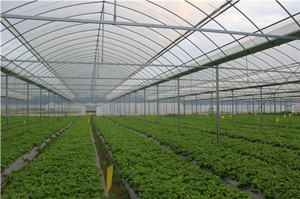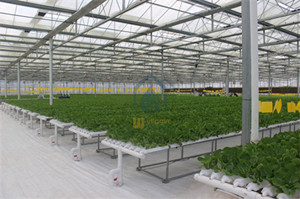Applying too much ammonium nitrogen fertilizer at one time will reduce the effect of certain bacteria and cause local acidity in the soil. When the PH value is less than 5, nitrous acid gas is produced, which can cause white spots on the vegetable leaves, and serious whole leaves become white and dead. It is often misdiagnosed as powdery mildew. Vegetables that are sensitive to nitrous gas include eggplant, cucumber, zucchini, and celery. , Pepper, etc.
If the quality of the agricultural film or mulch film is poor, or there is mulch film residue in the ground, it is exposed to the sun, and under the high temperature conditions inside the greenhouse, it is easy to volatilize and produce harmful gases such as ethylene and chlorine. When the concentration reaches a certain level, the vegetable leaf margins or veins will turn yellow, and then turn white. In severe cases, the whole plant will die. It is often misdiagnosed as bacterial keratoderma, which is particularly harmful to cucumbers. In addition, heating in winter is heating up, and if the fuel is not burned sufficiently, toxic gases will be generated, and if the ventilation is not timely, too much carbon dioxide will accumulate. Affect vegetable production.
Two, prevention:
The organic fertilizer used in the greenhouse must be fermented and decomposed, the chemical fertilizer must be high-quality, and urea should be mixed with calcium superphosphate. The base fertilizer should be applied 20 cm deep, and the topdressing chemical fertilizer should be about 12 cm deep, and water in time after application.
In sunny and warm weather, ventilation and ventilation should be combined with temperature adjustment, and ventilation and ventilation should be properly conducted in rainy and snowy weather.
As an important element of crop growth, light has always been the focus of attention of growers when considering key elements such as yield and quality. Many discussions in the industry include how to maximize the use of natural light, how to work hard from the top of the greenhouse glass to make crops more efficient in light use, and whether there are better use and combination of curtains, etc., are all around this topic, all for the sake of Provide the best growing conditions for crops.
This article will explain from which angles in the greenhouse can be considered to optimize the lighting conditions to maximize the light received by the crops.
In order to achieve the best and most favorable light conditions, you first need to focus on the development of your own greenhouse, analyze what kind of investment is the most ideal, and also need to consider the greenhouse itself and those that can be optimized and improved.
The first point that needs to be considered is how to maximize the use of the basic natural conditions in the greenhouse, that is, natural light. Optimum use of the gifts from nature is the first step of development in accordance with local conditions, so as to achieve more energy into the greenhouse under the most self-contained situation.
In addition to a good understanding of the local basic climate conditions, for the construction conditions of the greenhouse itself, if you want to increase the degree of light entering the greenhouse, you can think from the following aspects:
Different covering materials and coatings:
The use of this kind of covering products on the top of the greenhouse can effectively help the sunlight to be more evenly distributed in the greenhouse, not only on the horizontal surface, but also on the vertical surface, that is, reducing the light density on the top of the plant, so that the plant The light exposure at the bottom can also be increased, allowing crops to absorb energy in a more balanced manner for photosynthesis. Of course, in view of the different local climate and the relevant characteristics of the crops, there are coatings that can help isolate more excess heat inside the greenhouse in summer and prevent crops from high temperature or burns.
Optimization of the use of the curtain to maximize the entry of light:
As an indispensable part of greenhouse construction, screens can be installed, selected and used in combination, and growers can also work hard to achieve the optimal plan design for crop growth in the greenhouse, especially in the face of the changing seasons of the greenhouse. Challenges of different temperatures, humidity and radiation levels inside and outside. In recent years, various screen manufacturers have also invested a lot of energy in the research and development of the material of the screen, and strive to bring more convenience and combination advantages to the growers in the realization of the material and structure of the screen.
Clean up floating dust and green algae on the roof. In addition, in winter, the importance of light for crops in the greenhouse will be more prominent. Because the total amount of natural light is already very limited, it will become more difficult to collect enough light for crops from nature. At this time, the use of fill light is a natural choice.
In order to allow the growth and development of crops in the greenhouse, it is necessary to strictly control the environmental humidity in the greenhouse, mainly adjusting the air humidity and soil humidity. Next, we will introduce how to adjust the humidity of the greenhouse.
1. Air humidity
The purpose of air humidity regulation is to reduce the relative humidity of indoor air and reduce condensation on crop leaves. There are four ways to reduce air humidity in modern greenhouse production:
(1) Ventilation
Ventilation is a simple and effective way to adjust the humidity environment of a greenhouse. The humidity in the greenhouse is generally higher than that of the outdoors. The air with relatively low humidity is introduced through ventilation, which can dilute the indoor air.
(2) heating
Under certain indoor air humidity conditions, increasing the temperature of the greenhouse through heating can naturally reduce the relative humidity of the indoor air. If ventilation and heating can be combined, the relative humidity of indoor air can be effectively reduced.
(3) Improve irrigation methods
In the greenhouse, water-saving irrigation measures such as drip irrigation and micro-sprinkler irrigation can reduce ground water collection and significantly reduce ground evaporation, thereby reducing the relative humidity of the air. Similarly, the use of plastic film covering can also evaporate the ground water vapor.
(4) moisture absorption
The use of moisture-absorbing materials such as lithium oxide to absorb moisture in the air can reduce the moisture content in the air, thereby reducing the relative humidity of the air. In some cases, the greenhouse needs to be humidified to meet the needs of crop growth.
2. Soil moisture adjustment
For greenhouses, the purpose of soil moisture regulation is to meet the water demand of crops, so the amount of irrigation should be determined according to the water demand of different crops in different growth periods.
Through the above introduction to the humidity adjustment of the greenhouse, we know that the humidity can be adjusted from the two aspects of air and soil, but you also need to pay attention to the above mentioned content during operation.
While the threat of coronavirus (COVID-19) continues to impact activity around the world, people all over the world are trying their best of promoting production and protecting people’s livelihood on the basis of strict prevention and control of the COVID-19.
7, The customer shares the progress of installation to the supplier, the supplier response in time.
First of all, allow me congratulations to one of our customer in Africa is nearly finished the installation of the Muti-span film greenhouses by himself, a video from the customer as following:
Secondly, those greenhouses are designed, fabricated and sold by us, how he set up the greenhouse without we dispatch a technician for guiding at site?
1, We supply the detailed installation instruction manual.
2, We answered the questions in time during the set up, we have our team to working on the after-service issues on China time 8am to 11pm.
3, We check the details from the photos which customer sent us, and ask customer to correct it if there is any not correct.
4, The customer can read the drawing.
5, The customer read carefully of the installation manual before the each step of the installation, and prepare all the materials one day or two days before the installation according our material list.
6, The customer can get the team for civil engineering installation, greenhouse structure installation and hydroponic growing system.

1, The manufacturer has their expert team to service you, you can get feedback from the supplier in time if you have any question on the greenhouse or hydroponic growing project whenever before buy period, in buying period or after buying period.
2, The manufacturer should consider the climate of the project site and have rich design experience for various types of greenhouses.
3, The manufacturer has their own farm, fabricating factory and demo greenhouse.
4, The manufacturer would like to make different design of greenhouse or hydroponic system base on your budget.
5, The manufacturer can dispatch their on-site technician to support the installation if customer ask for, of course, this is chargeable.
6, The manufacturer has an option of guide the set up of greenhouse of online, please see details upward of ‘how he set up the greenhouse without we dispatch a technician for guiding at site?’.
Finally, I would like to make a brief introduction of our company, Xiamen Wellgain Greenhouse Engineering Ltd. Co. from China, a-15-year experienced in greenhouse designing, fabricating and construction company, we have our own farm overing an area of more than 20 acres, we warm welcome you to contact us if you have any issue on the greenhouse project, hydroponic growing system and Family hydroponic gardening system, we looooking forward to hearing from you, my friends.
1.Selection of strawberry varieties in greenhouses
After years of development in our country’s strawberry market, our chief has to choose popular varieties, because popular varieties are some varieties that have been tested in the market for many years. They are good regardless of their yield and taste, such as cream strawberry, red face, sweet Charlie , Nvfeng, etc. At the same time, virus-free seedlings are currently popular in strawberry seedlings. We need to order strawberry seedlings from the seedling farm. We can listen to the opinions of the seedling farm. Professional virus-free strawberry seedlings have high yield, good appearance, and strong disease resistance. At the same time, buying seedlings directly can save yourself the time for seedlings. In addition, strawberry seedlings are generally used once a year, and degradation will occur if they are continuously cultivated.
2. Strawberry planting matters
2.1. Planting time
The planting time is from early September to early October. Ordinary ground planting needs to prepare the ground 25 days before planting, and apply 5,000 kg of high-quality decomposed organic fertilizer per acre, 100 kg to 150 kg of biological potash fertilizer, 30 cm deep, ridge height 10 cm to 15 cm, and ridge surface width 40 cm ~50 cm, ridge spacing 15 cm ~ 20 cm, north-south ridges, sunny, sterilization and insecticide for planting. If you use three-dimensional elevated planting, you only need to lay the organic matter in the cultivation tank. Generally, the organic matter can be used for several years with integrated water and fertilizer irrigation equipment.
2.2. The choice of greenhouse
Strawberry is a low-temperature planting crop, as long as the temperature inside the greenhouse is higher than four or five degrees above zero, it can be planted. At present, some agricultural parks like to use glass multi-span greenhouses for the cultivation of elevated strawberries, which has the effect of sightseeing and picking.
2.3. Temperature management during the bud to the first flowering period, the suitable temperature during the day is 20℃~30℃; during the harvest period, the temperature is above 8℃; the temperature in the shed during the day should be ventilated in time. Bottom wind.
2.4. Flowering period management The optimal temperature during the flowering period is 20℃~25℃ during the day, 5℃~6℃ at night, and the minimum temperature cannot be lower than 3℃; the optimum humidity in the shed during the flowering period is 50%~60%. If it is too large, timely ventilation should be required. Wet; no watering or spraying during the flowering period; no fertilization or spraying during the flowering period to prevent damage to the flowers; pollination by bees during the flowering period.

3. What is the yield of strawberries
The ripening period of strawberries is different, so one crop of strawberries should be picked in batches, usually every two or three days. The yield per mu of strawberries in one season depends on the variety, some are relatively high, up to 3 tons, and generally 1 ton. about. The above is the traditional planting mode. If the elevated strawberry planting method is used, the planting quantity will be about twice to three times that of the traditional planting, so the output will be correspondingly turned over.
Strawberry is a well-loved agricultural product. We growers need to regain confidence and actively resume production. At the same time, we also need to actively try online sales and surrounding group purchases to stop losses.
Pay attention to greenhouse engineering technology and serve modern agriculture
Strawberry likes warm and cool climate:
Strawberry root system growth temperature is 5-30℃, suitable temperature is 15-22℃, the suitable temperature for stem and leaf growth is 20-30℃, buds will be frozen at -15-10℃, the temperature of flower bud differentiation period must be kept at 5-15℃, and the flower will bear fruit 4-40 ℃. In summer, when the temperature is higher than 30℃ and the sunshine is strong, shading measures should be taken.
Strawberry is a light-loving plant, but it has strong shade tolerance:
When the light is strong, the plant is short and strong, the fruit is small, the color is dark, and the quality is good.
Medium light, big fruit, light color, low sugar content, longer harvest period.
Too weak light is not good for strawberry growth.
Strawberry's watering requirements:
Strawberry has a shallow root system, a large amount of transpiration, and at different growth periods the water requirements slightly different. Strawberries are not tolerant to waterlogging.
The correct watering time:
usually it is necessary to choose to do it in the afternoon on a sunny day. If it snows or rains, it is not necessary to water, otherwise the environmental humidity in the greenhouse is too high and it is easy to cause disease.
Water should not be watered at noon, especially when the flowering period is approaching, it will interfere with normal pollination, and the grown fruits are prone to deformities. After entering the blooming period, the daily watering amount should be controlled, and the strength of the wind should be converged, otherwise it is easy to cause poor pollination and fertilization.
In the greenhouse, the root system of strawberry is usually shallow, but the leaf area is larger, and it likes a humid climate. The amount of irrigation should not be too much, otherwise the roots will not be able to breathe freely, it will be easy to rot and blacken, and finally the whole plant will die.
Drip tape irrigationcan be used, and fertilizer can be added at the same time as watering. This irrigation method can effectively improve the humidity, reduce the occurrence of diseases, and at the same time increase the surface temperature, maintain the normal air permeability of the medium, and promote the development of the root system.
Management after irrigation is also very important. You can usually check the weather forecast before irrigation. If it rains continuously in the next few days, you can seal the greenhouse after watering and wait for the temperature to rise before ventilating.
Regarding watering the strawberries, there is one more thing to pay attention to. Control the temperature of the water, especially in winter. If the water temperature is too low, it will affect the development and quality of the fruit. It is best to keep it at about 25 degrees.
1. Hydroponic equipment: the equipment is generally divided into pipeline type, three-dimensional nutrition membrane type, tidal type. For large-scale vegetables, cement tanks are generally planted and used to lay plastic. The cheapest is to put on the tank on the shelf. The cost is relatively high. Most of the pipelines are used in sightseeing agriculture. The advantages are beautiful, the nutrient solution is not easy to infect, and the disadvantages are not easy to clean. If the length is exceeded, itching measures are needed. The column type is required, The advantages of the nutrient liquid membrane type and tidal type are considered. The spatial utilization rate is the most efficient, the disadvantage cost is high, and the non experienced person is difficult to DIY. However, this is the most beautiful and the highest utilization space rate at present, and can rotate.
2. Nutrition solution: currently, most of the nutrient solutions are general formula, generally divided into three mother solutions, two of which are transparent solutions, one is that trace elements are mostly yellow brown or brown due to chelating iron. The high multiple of the three solutions cannot be mixed, because precipitation fails, so most of them are diluted with water first, and then configured together according to the standard multiple. Normally, it is light brown, a small amount or no white precipitation. If a large amount of precipitation occurs, dilution and stirring is insufficient, and the nutrient solution needs to be re mixed.
3. Seedlings: germinate to a true leaf, only clear water is used, and no nutrient solution is used. Once the cotyledon is out, it is necessary to reduce water and ventilate the light immediately. When no soil is available, it is necessary to prevent the length of the seedling and the most easily to grow. After a true leaf, it starts to add half concentration. EC can be accepted in 500-800. If it grows to 4 to 5 real leaves, it can be planted on the equipment. The standard concentration nutrient solution can be used
The internal shading system can improve the ecological environment in the greenhouse by adjusting the light
In summer, when the indoor temperature rises to a certain value, it can reflect part of the sunlight according to different shading rates and diffuse the sunlight into the room to achieve the purpose of cooling; closing the inner shading curtain can reduce the temperature of the greenhouse by 4~6℃ to reduce the indoor The required temperature.

On the contrary, at night in winter, closing the inner shading screen can effectively prevent infrared rays from escaping. When the greenhouse or indoor temperature at night drops to the set low temperature limit, close the inner shading screen to strengthen the greenhouse's heat preservation and reduce the loss of ground radiant heat. , Reduce heating energy consumption, greatly reduce the operating cost of the greenhouse; In the daytime, the inner shading curtain can be opened to make the greenhouse full of light. The system is controlled by a separate motor.
The inner shading screen is equipped with an inner shading system under the gutter in the greenhouse. The inner shading material adopts aluminum foil shading screen, which is made of 4mm wide aluminum foil and polyester material woven by high-strength polyester yarn. The special aluminum foil and polyester give outstanding radiation reflection and transmission functions, so as to ensure that the indoor temperature during the day is low and the energy-saving effect is very good. The temperature of the crop at night is basically the same as the ambient temperature. Good indoor climate conditions avoid leaf condensation, reduce diseases, and reduce energy costs.

The woven structure of the aluminum foil shade screen allows sufficient water vapor to pass through and prevents condensation at the bottom of the screen; because the screen is a high-strength anti-ultraviolet, anti-static product, it can remain clean and effective after many years of use. The UV stabilizer added in the material is resistant to chemicals commonly used in greenhouses.
Due to the fact that the Khulna region of Bangladesh is very prone to floods and the soil has a high salt content, farmers in this region have been unable to make good use of the land to grow crops and vegetables. "We can neither grow crops nor raise fish," said a 45-year-old farmer in the Satkhira district of southwestern Bangladesh.
As we all know, Bangladesh has flat and fertile land, which is very suitable for growing crops and vegetables throughout the year. However, as the water level rises, the land in the southern part of the delta is becoming less and less suitable for planting.
Dr. A F M Jamal Uddin, a professor in the Department of Landscape Architecture of Bangladesh Agricultural University, hopes that hydroponics can solve this problem. He pointed out a series of challenges to realize hydroponics cultivation. Because the cost of hydroponics is very high, Bangladesh is still far away from the commercialization of this method.
In order to ensure that hydroponics can bring sufficient benefits to crops, crops need to be grown in a film greenhouse made of special polyethylene materials, which helps control the temperature in the greenhouse. Rain and bad weather will be one of the challenges facing thin film greenhouses. In order to reduce rain and bad weather damage to the film greenhouse, a more durable polyethylene material made in Israel can be used.
As there is less and less dry land in the area, local farmers are forced to practice hydroponic garden farming. The current hydroponic technology has been greatly developed, and the yield of crops harvested by this technology has been increasing year by year. Due to the salinization of local land, this method of growing agricultural products has become more and more necessary. Through the use of hydroponics, high-value crops can be planted throughout the year without the use of soil.
The Bangladesh government has been working hard to promote hydroponics to grow crops, especially in areas where monsoon rains are prone to flooding. In 2013, the government approved a project worth 1.6 million US dollars to promote the development of hydroponic agriculture, which covered 12,000 households in 8 districts of Bangladesh.
- Buddha Jump Over the Wall1
- Canned Abalone2
- Canned Turtle Soup1
- Edible Bird's Nest2
- Frozen Foods1
- Frozen Seafood8
- Jelly/Pudding Applications1
- Meat Product Applications2
- Others Applications5
- Plant-based meat Product Applications1
- SURIMI2
- Soft Candy1
- Soft Candy Applications4
- bottle1
- can end2
- packaging film2
- tableware3













